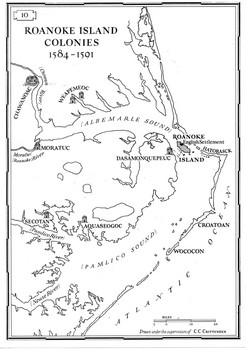The Lost Colony of Roanoke
Part 3: The Mystery Endures White arrived home in England and immediately set about raising money and interest in a return to Roanoke. He wanted to get back as quickly as possible, since he knew that supplies were running low. By the time that he was able to make progress, however, he couldn't leave. It was 1588, and the Spanish Armada was advancing on England. After several desperate weeks, the English defeated the massive Spanish fleet and sent it sailing home. But the war between England and Spain was by no means over, and White and the men he wanted to take with him back to Roanoke were unable to leave, whether because they themselves were fighting in this war or because they just weren't able to get a ship. Finally, in 1590, White and a few sailors and ships sailed back to Roanoke. They arrived in mid-August, seeing smoke from two separate places on the island. They hoped that this smoke was from the settlements that they had left behind. On August 16, they searched one area but found nothing. The smoke was from a forest fire. The next day, seven men drowned when their boat capsized. White went on, with a handful of men. It was so late in the day when they arrived at their destination that they couldn't go ashore safely. Desperate for some sign from the settlers, they played familiar English songs on a trumpet but heard nothing in response.
In desperation, White went to a secret hiding place, where he had buried chests and heirlooms. He discovered that nothing was left but cover-less books and ruined pictures and maps. The entirety of what the men found looked like it had been abandoned for some time. Since he knew that the Croatoans lived in a nearby island and that they had been friendly to him and other English people in the past, White decided to sail to that nearby island and search for the settlers there. Again, they met with frustration. A strong storm prevented the ships from sailing in that direction, many times. In fact, the last time, the winds were so strong that the men found themselves being blown back to England before they could right themselves. (Remember that in those days, sails were the primary means of powering a ship. Storms and winds played a major part in when and where sailors took their ships. The winds that blew White and his men eastward did not let up, leaving them with no choice but to sail home. Exploration was expensive in those days. White didn't have the money to pay for another voyage. Neither, it turns out, did Sir Walter Raleigh. By the time English settlers arrived at Jamestown in 1603, the fate of the Roanoke colonists was a mystery that didn't have enough evidence to be solved. Some people reported seeing fair-skinned people on Croatoan Island. Others reported seeing evidence of settlements along the North Carolina coast. To this day, no one can say for certain what happened to the Roanoke Colony settlers. First page > The Beginning > Page 1, 2, 3 |
|
Social Studies for Kids
copyright 2002–2025
David White



